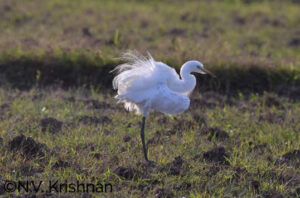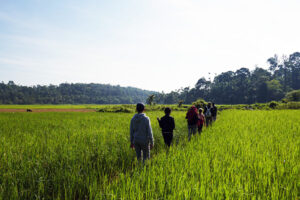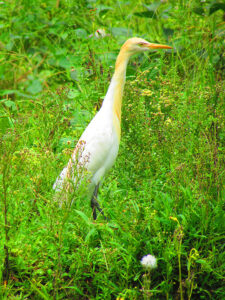Interview with N.V. Krishnan, professional wildlife photographer and birdwatcher
Did you know that Wayanad is home to more than 350 bird species? At the Uravu Bamboo Grove Resort the preservation of Wayanad’s exceptional biodiversity and wildlife is very important. This is why we are a bird and butterfly-friendly space.
Whether you are an experienced birdwatcher or a first-timer, this is an ideal place to enjoy our “Birdwatching Tour” with our local naturalist guide, N.V. Krishnan. He will tell you everything you need to know about the local birds and will show you both the birds themselves and his stunning photographs.
To understand a little bit more about the situation of the birds in Thrikkaipetta village and how N.V. Krishnan became passionate about them, we decided to interview him.
- When did you first become interested in birdwatching and why?
I started photography and birdwatching 22 years ago, and at the same time I also started to try to protect the birds and their habitats.
I became interested in them because they help me. They eat the insects in my garden and thanks to them I do not need to use any pesticides or other chemicals to keep my fruits and vegetables healthy. Furthermore, they are a really important component of the food chain.
- Where are you located and which species do you spend most time observing?
I am located in Thrikkaipetta village – to reach my house you have to walk for about 10 minutes through the paddy (rice) fields, as there is no road. This makes my place really quiet and a perfect place to observe nature and the birds.
In Thrikkaipetta, there are about 146 bird species; 40 of them have migrated from within India itself and five species from other countries, such as Mongolia. Most of the time, when I go out birdwatching, I am able to see over 100 species in one day. The most common species you can see here are Bulbuls, Woodpeckers, Barbets, Vernal Hanging Parrots, Drongos, Eagles, Kites, Ducks and Malabar Grey Hornbills.
- What is the current situation of the birds in the village in terms of numbers and variety of species?
The number of birds is increasing; however, the number of species is decreasing. This is mainly due to air and water pollution, deforestation and usage of pesticides for farming.
- Which bird is your favourite? Why?
They are all my favourites, but if I had to pick one I would say the Spot-billed Duck. In 1992 there were only two of them but now Thrikkaipetta hosts more than 600 Spot-billed Ducks. Here again, this rapid increase is due to climate change.
- What rare bird would you like to see the most? Why?
I would say the Amur Falcon, because I have only seen it once here and that was 2 years ago. I would love to see it again.
- Where is the best place you’ve been to for birdwatching?
Here, in my garden and in the forest on the Mannikunnumala(the mountain behind the village).
- What unusual things have you done or places have you gone to see birds?
I spotted for the first time in Kerala the Bonelli’s Eagle at breeding time. This was on the Mannikunnumala. When I spotted him, I had built a hide on a tree at around 60 feet from the ground. For 24 days in a row, I woke up at 5.30 am, hiked 2 hours through the jungle to reach my hiding spot and observed this beautiful bird. The first feeding took place at around 8 am and that is why I had to get there early. I would only go back home at the end of the day at around 8 pm.
Otherwise, I go up there at least once a week to observe the wildlife and take pictures.
- What equipment do you use?
I use binoculars, my digital camera and a tripod.
- Can you tell me about your famous “sniper” camera
Sure, it is a Pentax Sportmatic with a 300 mm fixed telephoto lens and it is still fully functional. It is a really old model; as you can see, the lens was made in the USSR. I am really proud of this camera because I have won 26 national awards with it. I used to go to Kalpetta (the closest town) to a studio where I would do the printing myself.
Unfortunately, I had to change to a digital camera because it is not possible to find the films for it any more (here in Wayanad).
- Tell me about your initiatives to protect the birds
I mainly use my photographs, slide shows and also the birdwatching tours to raise people’s awareness not only about the extraordinary biodiversity of this place, but also its fragility.
- How can the average person or tourist best help the birds?
To help the birds, people should plant more fruit trees or bushes to provide the birds with food. They should also take care of the freshwater sources as they are often contaminated with plastic or chemicals.
A really sad example I can give you is that we used to have a Kingfisher family nesting in my garden. However, one day they caught a crab from the local stream, but the pesticide used by a farmer had contaminated this crab, thus the whole family of Kingfishers was wiped out. The same happens with the local fish – it is the whole food chain that is contaminated.
- Can you observe the impact of climate change on the local birds?
Yes of course. Firstly, as I already told you, the number of species is decreasing but the number of birds is increasing, meaning that only the “fittest” survive and there is a loss of biodiversity.
Secondly, birds usually lay their eggs at a fixed time every year. With climate change, it is getting too hot for certain birds to lay their eggs, so they experience late breeding. For instance, now in June, it is on average 10 degrees hotter than what it used to be, so some birds that should have finished breeding by April still haven’t finished yet.
So yes, I am really troubled by all these changes and hope we can do something about it; otherwise, the biodiversity will be badly affected.
- Thanks a lot for your time and all your answers
Thank you!







